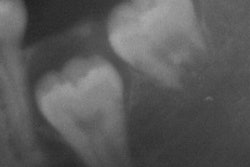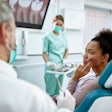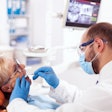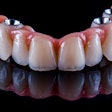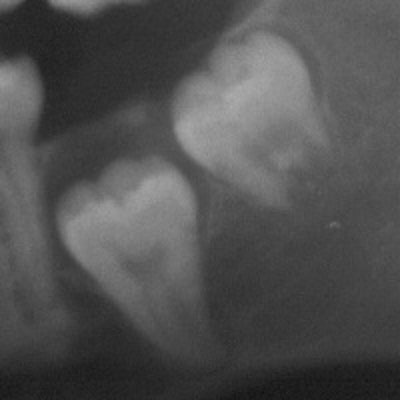
The prophylactic extraction of unerupted asymptomatic third molars may be beneficial. A new study analyzing data gathered from the U.S. Veterans Affairs (VA) Dental Longitudinal Study has concluded that "the presence of a third molar that was soft-tissue impacted increased the risk of incident second-molar pathology 4.88-fold" (Journal of Dental Research, December 2013, Vol. 92:12, pp. 1095-1099).
However, the researchers, hailing from several U.S. universities, as well as Korean and Japanese institutions, warned that the conclusions were linked to a very specific dataset. "There are important limitations since the patient population is composed primarily of middle-aged men at baseline," lead author Martha Nunn, DDS, PhD, the director of the Center for Oral Health Research and an associate professor at Creighton University School of Dentistry, stated in an email to DrBicuspid.com. "Many potentially problematic third molars would have been previously removed."
Nevertheless, there are aspects of their results that are noteworthy. "It did appear that the few soft-tissue impacted third molars tended to pose more of a risk than other types of third molars," Dr. Nunn noted. "In contrast, bony impacted third molars did not seem to pose any more risk than erupted third molars."
The merits of prophylactic third-molar removal have been hotly debated. Detractors claim the procedure merely lines the pockets of oral surgeons, while supporters tout its importance in preventing more severe indications and costly treatments in the future. For now, the only certainty is the need for scrutiny of the procedure, given its status as "the most common oral surgery procedure in the United States," the researchers noted. Those outside of dentistry may be shocked to hear that "limited evidence exists to justify [the] costs and associated morbidity" of such a commonly performed procedure.
Selecting participants
The researchers were able to include in their study a fairly large cohort from the data subset of the closed-panel longitudinal VA Normative Aging Study. From this study of 2,280 voluntarily enrolled healthy Boston-area men between the ages of 25 and 84, 1,231 enrolled in the Dental Longitudinal Study dating back to 1969. These men were not VA patients and received care from private providers. Every three years, they received panoramic and intraoral full-mouth radiographs during comprehensive oral examinations.
“We would recommend ‘watchful waiting.’ ”
Ultimately, the researchers found 416 subjects that had both their first and second molars present in at least one quadrant at baseline. Those included also had one or more follow-up exams. Third-molar status was broken down into three categories: absent, erupted, or unerupted. Unerupted teeth were further classified as "soft-tissue" or "bony" impacted. Next, they analyzed the association of third-molar status to second-molar outcomes cross-sectionally and longitudinally. Second molars adjacent to absent third molars served as a reference group.
The researchers found that "both the prevalence and the incidence of periodontal pathology of secon molars varied significantly depending on whether adjecent third molars were absent, erupted, soft-tissue impacted, or bony impacted."
This was confirmed in the cross-sectional analysis, in which the researchers found that "prevalent second-molar disease differed significantly according to third-molar status." Distal caries were more likely to occur in second molars adjacent to erupted third molars than to absent ones for an odds ratio (OR) of 1.73. And second molars were more likely to have distal bone loss of 20% or more if they were adjacent to soft-tissue impacted molars and a distal probing depth of more than 4 mm (OR = 4.93), the researchers reported. Lastly, bony impacted third molars were more likely to cause distal bone loss of 20% or more, for an OR of 2.64.
In the longitudinal analysis, the researchers's results produced similar trends to those in the cross-sectional analysis.
Soft-tissue impacted molars were particularly influential on the distal of second-molar periodontal pathology in terms of probing depth greater than 4 mm and distal bone loss of 20% or more. Caries, however, were only an increased threat to second molars if the third molars were erupted.
The researchers cautioned clincians from embracing prophylactic third-molar removal, however, citing several studies that found insufficient evidence to support the associated cost and risk of the procedure. They also acknowledged the published work of the American Association of Oral and Maxillofacial Surgeons' outlining indications for asymptomatic third-molar removal. In her comments to DrBicuspid.com, Dr. Nunn reiterated her position.
"Blanket prophylactic removal of third molars is probably not warranted, but further studies really need to be conducted to determine which types of impactions really pose a serious risk and which impactions might better be left alone," she explained. "Based on the results of our study, we would recommend 'watchful waiting.' "
Without question, more research is needed.
"Further research needs to be conducted to carefully tease out which types of impactions pose serious risk and which impactions are better left alone," Dr. Nunn said. "To accomplish this, we really need to conduct a large-scale epidemiological study to determine which types of impactions pose the most risk, with classification divided into more categories than simply soft-tissue impacted third molars and bony-impacted third molars.
"If anything," she acknowledged, "our study raises more questions than it answers."




